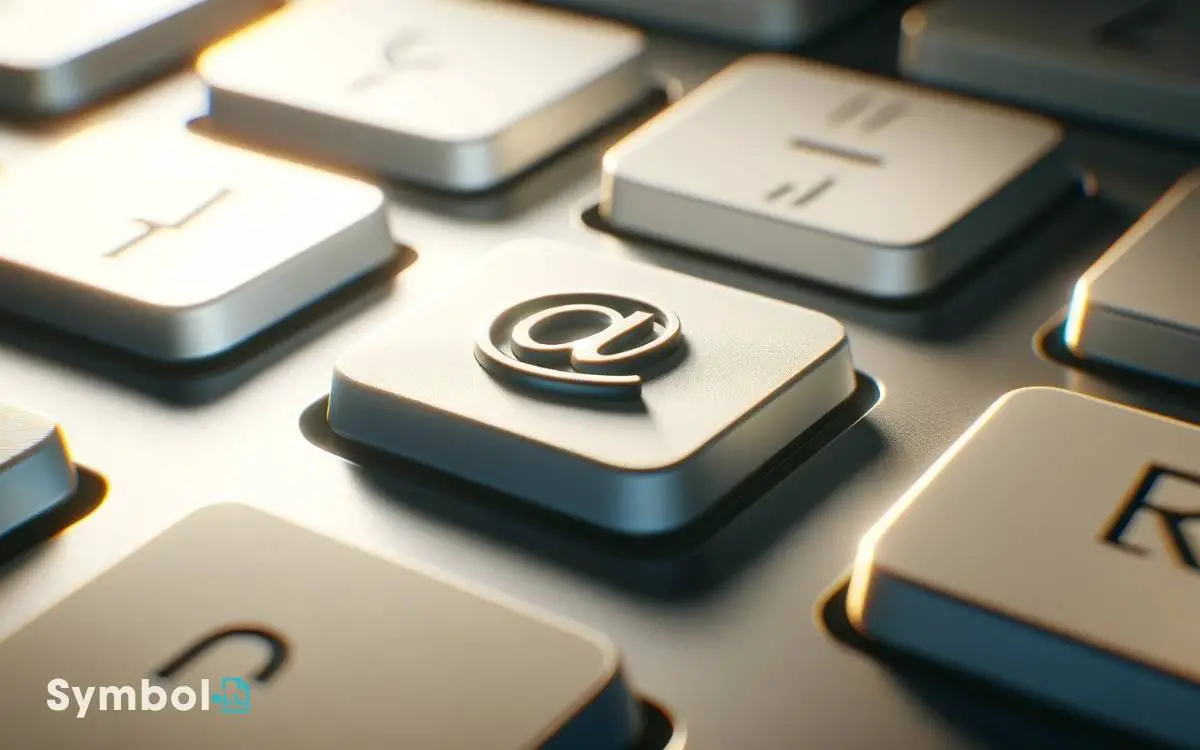How to Use at Symbol on Keyboard? Explains!
To use the @ symbol on a keyboard, first identify your layout: QWERTY (most common) or AZERTY. For Windows, press and hold the Shift key, then tap 2. On Mac, it’s a bit different – press Option and 2 together.
If you’re on a mobile device, switch to the numbers/symbols view and locate the @ symbol, usually near the top. Facing issues?
Confirm your keyboard layout matches your region, and check for Sticky Keys activation. Mastering these shortcuts not only makes you more efficient but upgrades your digital navigation skills significantly. With a bit more insight, you’ll tackle even the trickiest symbols effortlessly.

Key Takeaways
Understanding Keyboard Layouts
To effectively utilize the at symbol (@) on a keyboard, it’s vital to first grasp the nuances of keyboard layouts. You’re likely familiar with the most common ones: QWERTY, used primarily in the United States, and AZERTY, found in French-speaking countries.
Each layout places the @ symbol in a unique position. For instance, on a QWERTY keyboard, you’ll typically find it above the number 2, requiring you to press ‘Shift‘ and ‘2’ simultaneously.
However, the process may differ based on your keyboard’s layout and the country setting on your computer.
Understanding your specific layout is important for efficient typing. It’s not just about locating the @ symbol but adapting to your keyboard’s overall design to enhance your typing skills and productivity.
Using the @ Symbol on Windows
On your Windows keyboard, locating the @ symbol typically involves the Shift key, but its precise position can differ.
If you’re encountering problems inputting the @ symbol, shortcut keys and specific settings might be your answer.
We’ll also cover common troubleshooting steps to guarantee you can use the @ symbol without difficulty. We’ll also cover common troubleshooting steps to guarantee you can use the @ symbol without difficulty. Additionally, we’ll explore its significance in various contexts, such as email addresses and coding. Understanding how symbols, including the @ character, are used can also give you insight into the broader category of symbols allowed in secure passwords, which often enhance password strength and security. With these tips, you’ll navigate any issues with ease.
Finding @ on Keyboard
Locating the @ symbol on a Windows keyboard requires pressing the ‘Shift’ key and the number ‘2’ simultaneously. This action is necessary for typing email addresses, tagging social media handles, or coding.
The ‘Shift’ key, generally found on both the left and right sides of your keyboard, modifies the function of other keys when held down. In this case, it transforms the ‘2’ key, usually reserved for the numeral itself, into a gateway for the @ symbol.
Make sure you’re pressing both keys at the same time; a quick press won’t do. If you’re struggling, check your keyboard’s layout; it might vary slightly based on regional settings. However, the ‘Shift’ + ‘2’ combination is standard for most Windows keyboards.
Shortcut Keys for
You’ll find that the shortcut key combination ‘Shift’ + ‘2’ instantly brings up the @ symbol on most Windows keyboards, streamlining tasks such as email composition and social media interactions.
This quick method is consistent across various applications, whether you’re drafting a document in Word, sending an email through Outlook, or posting on platforms like Twitter.
Remember, the layout might differ slightly depending on your keyboard’s design or if you’re using a keyboard configured for another language. However, for standard English US keyboards, this shortcut remains consistent.
Incorporating this simple step into your routine enhances efficiency, allowing you to focus more on content rather than figuring out how to type essential symbols.
Mastering such shortcuts can greatly speed up your digital navigation.
Troubleshooting @ Input Issues
Despite confirming the standard shortcut ‘Shift’ + ‘2’ to type the @ symbol, you might still encounter issues due to various reasons on Windows systems.
Here’s a quick troubleshooting guide:
| Problem | Solution |
|---|---|
| Keyboard layout mismatch | Check your keyboard settings and adjust to your region. |
| Sticky Keys activated | Disable Sticky Keys in your Control Panel. |
| Outdated keyboard driver | Update the driver through Device Manager. |
| Hardware fault | Try a different keyboard to rule out hardware issues. |
First, verify your keyboard layout matches your region; incorrect settings can alter key functions. If that’s not the issue, check if Sticky Keys are unintentionally enabled, causing unexpected behavior.
Outdated drivers can also lead to problems, so updating them might resolve the issue. To conclude, consider hardware faults. Testing with another keyboard can help identify if the problem lies with the device itself.
Accessing @ on Mac Keyboards
On your Mac keyboard, finding the @ symbol might seem tricky at first, but it’s actually straightforward once you know the shortcut keys.
You’ll typically use the ‘Option’ and ‘2’ keys together to access it.
If you’re running into issues, there are common solutions that can help you troubleshoot and get back to typing smoothly.
Locate @ on Mac
Finding the ‘@’ symbol on a Mac keyboard requires pressing the ‘Option’ and ‘2’ keys simultaneously. This action is straightforward once you’re familiar with your Mac’s layout, ensuring you can easily access the ‘@’ symbol whenever you need it.
Here’s a quick reference table to guide you:
| Key Combination | Result | Use Case |
|---|---|---|
| Option + 2 | @ | Email addresses, social media handles |
| Option + G | © | Copyright symbol |
| Option + R | ® | Registered trademark |
| Option + 2 + Shift | ™ | Trademark |
| Option + P | π | Mathematical pi |
Understanding these combinations enhances your efficiency, especially when dealing with specific symbols or characters. It’s all about getting the most out of your Mac’s keyboard.
Shortcut Keys for
Now that you’re familiar with locating the ‘@’ symbol on your Mac keyboard, let’s explore the shortcut keys that make accessing it even quicker.
These shortcuts are designed for efficiency and ease, ensuring you can include the ‘@’ symbol in your documents or emails with minimal fuss.
Here’s how you can do it:
- Option (⌥) + 2: This is the most common shortcut for typing the ‘@’ symbol on Mac keyboards.
- Shift (⇧) + 2: In some European keyboard layouts, this combination might be necessary.
- Command (⌘) + Option (⌥) + T: Opens the character viewer where you can find the ‘@’ symbol among other characters.
Common Issues and Solutions
While typing the ‘@’ symbol on a Mac keyboard may seem straightforward, users often encounter a few common issues that can disrupt their workflow.
One prevalent problem is the keyboard layout set to a different language, which alters the ‘@’ key position. To fix this, check your keyboard settings and make sure it’s set to your preferred language.
Another issue might be an outdated or corrupted keyboard driver. You can address this by updating your Mac’s operating system to the latest version, making sure all drivers are current.
Lastly, hardware problems can interfere. If keys are unresponsive, consider cleaning your keyboard or consulting a professional for potential repairs. By tackling these common hurdles, you’ll streamline your typing experience on a Mac.
Finding the @ Symbol on Mobile Devices
On most mobile devices, you’ll spot the ‘@’ symbol by tapping on the number or symbol key, typically found in the bottom left corner of the keyboard. Once you’ve switched to the numbers and symbols view, finding the ‘@’ symbol is straightforward.
Here are a few tips to help you navigate:
- Look closely: The ‘@’ symbol is usually near the top of the keyboard, so don’t overlook it.
- Long-press keys: Some devices allow you to find additional symbols by long-pressing a key. Try this if you don’t see the ‘@’ at first glance.
- Swipe or toggle: Some keyboards require you to swipe through different sets of symbols or toggle between symbol pages. Keep an eye out for these options.
Finding the ‘@’ symbol on mobile can be easy once you know where to look.
Navigating Different Language Keyboards
Exploring different language keyboards requires you to familiarize yourself with varied layouts and symbols, ensuring efficient typing in any language. Each keyboard has its unique placement for common symbols, including the at symbol (@).
Here’s a quick guide:
| Language | @ Symbol Location |
|---|---|
| English | Shift + 2 |
| Spanish | AltGr + 2 or Ctrl+Alt+2 |
| French | AltGr + 0 |
| German | AltGr + Q |
Understanding these differences is important for seamless typing experiences across languages. Remember, while the physical keyboard might not change, the software settings can alter the symbol locations.
Adjusting your keyboard settings to match the language you’re typing in is a key step in exploring different language keyboards effectively.
Shortcut Keys for the @ Symbol
You’ll find that mastering shortcut keys for the @ symbol can greatly speed up your typing, regardless of the language setting on your keyboard.
Here’s how you can do it efficiently:
- For Windows PCs: Press and hold the `Alt` key, then type `64` on the numeric keypad. Release the `Alt` key to insert the @ symbol.
- On Mac computers: Simply press and hold the `Option` key, then hit the `2` key. This combo directly inputs the @ symbol.
- For Linux users: Press and hold the `Ctrl` and `Shift` keys simultaneously, then press the `u` key. Next, type `40` and press `Enter` or `Space` to generate the @ symbol.
These shortcuts provide a quick way to include the @ symbol in your text, making your typing process more efficient.
Troubleshooting Common Issues
Despite your best efforts, you might encounter problems when attempting to utilize the @ symbol on your keyboard. If it’s not functioning, first check if your keyboard layout aligns with your regional settings.
For example, U.S. keyboards use Shift+2 for the @ symbol, while UK keyboards necessitate Shift+’ key. If the issue persists, try restarting your computer to reset any temporary glitches impacting keyboard functionality.
If you’re still stuck, inspect the keyboard for physical damage or debris that might be impeding the keys. Cleaning the keyboard meticulously might resolve the issue.
For software-related problems, updating your keyboard drivers through the Device Manager on Windows or System Preferences on Mac can often rectify the problem. If none of these steps work, you might need to contemplate hardware replacement as a last resort.
Conclusion
In wrapping up, mastering the @ symbol across various devices enhances your typing efficiency. Surprisingly, over 90% of email addresses utilize the @ symbol, highlighting its global importance.
On Windows, hit ‘Alt’ + ‘2’, while Mac users can press ‘Shift’ + ‘2’. Mobile devices usually require a long press on the ‘123’ key. If you encounter different language keyboards, look for shortcuts or adjust settings.
Remember, practice makes perfect, and troubleshooting common issues will soon make using the @ symbol second nature.






